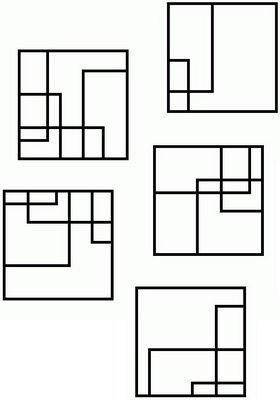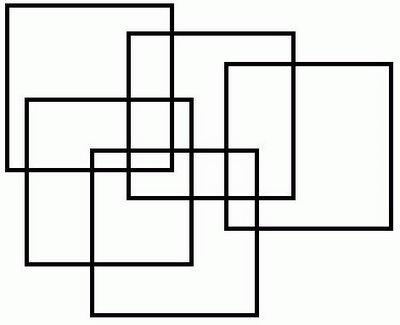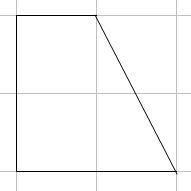Monday, August 20, 2007
Friday, June 08, 2007
Easy or Difficult?
 by Albert Frank
by Albert Frank
Recently someone gave me the following problem:
On the Xth day of the Yth month of the year 1900+Z in the 20th century, a ship is near New York. The ship has T crew members, U propellers and V chimneys. If we add the cube root of the age of the captain (who is a grandfather) to the product XYZTUV, the result is 698823. What are the values of X, Y, Z, T, U, V, and what is the age of the captain? We also know that only one solution is realistic.
Is this problem difficult or easy? Let’s have a look at it (the solution):
The age of the captain (who is a grandfather) is a perfect cube: It can only be 64 years old.
698823 – 4 = 698819.
Let’s make a decomposition of 698819 into prime factors: 698819 = 11 x 17 x 37 x 101. We have four factors. Six are needed, so the two others are 1 and 1.
11 would be a too big a number for propellers or chimneys, so the ship has 1 propeller and 1 chimney.
The month has to be <13, so it can only be 11.
The day has to be < 32, so can only be 17.
The year (Z) has to be < 100, so can only be 37.
The remaining number 101 is the number of crew members.
We have it: 17th November 1937, 1 propeller, 1 chimney, 101 crew members, and the captain is 64 years old.
Some will find this problem very easy, others will find it very difficult.
Tuesday, February 27, 2007
Crossword Puzzle
Across
9 Astronomical object consisting of a glowing shell of gas and plasma (9,6)
10 Bashed (7)
12 Region in central Italy (7)
13 Fruitful, profitable (9)
14 Pertaining to or containing sulphur
15 Variation of Tunica (7)
18 Tortoise deceased in Australia in 1996, the oldest known living creature at the time of her death. (7)
21 First name of the lady who was the editor of the New York Herald Tribune book review for 37 years, and who died in 1966. (5)
23 Informing, advising (9)
25 To receive after someone's death or departure or by natural descent (7)
26 Diffusion of molecules through a semipermeable membrane, the tendency of liquids to become equally diffused (7)
29 Corrupt or incompetent practitioner (particularly in law and medicine) (15)
Down
1 Multiple Purpose Operator Workstation (4)
2 Exhibiting senile behaviour or decay (4)
3 Fallen to a very low place or level (4-4)
4 Indian political leader and social revolutionary (6)
5 Teeth located between the incisors and the premolars (8)
6 Los Angeles (California, USA) band (3,3)
7 Small tree native of New Zealand (8)
8 Badge of the Lacys' (4,4)
11 Japanese first name (5)
15 Situation similar to a dilemma, but with three alternatives instead of two (8)
16 Hole caused by the removal or the loss of a nail or deliberately made for a nail (4,4)
17 Allowing for the easy removal of food particles (8)
19 Antibacterial drug (8)
20 Boredom (5)
22 Frames for airing or drying clothes (6)
24 ... for one's breeches (3-3)
27 Rocket or balloon sent into the upper atmosphere to measure phenomena beyond the reach of normal aircrafts (4)
28 Reproductive structures (4)
The solution will be appended here at a later time.
Wednesday, January 24, 2007
Another Trapezoidal Puzzle
 by Albert Frank
by Albert Frank
This puzzle is similar to the last year's trapezoidal puzzle but better.
Dissect the following trapezoid into four trapezoidal pieces of the same size and shape:
The solution will be provided at a later time whether you need it or not :)
Monday, January 22, 2007
Mnemonics and Blindfold Chess
Introduction
Mnemonics can be defined as "a technique of improving the efficiency of the memory"1. It sometimes means "a system to develop or improve the memory"2, implying a specific set of routines to achieve this improvement, but the first and wider definition is the one used here.
The goal of this article is to briefly describe what mnemonic techniques are and a few ideas regarding how they might be used when playing chess blindfolded. The research has consisted of articles and e-mail exchanges with the very competent blindfold player Hindemburg Melao Jr.
Footnotes are used exclusively to indicate sources or cross-references; a chess player is referred to as "he". Thanks to Andreas Gunnarsson, Eliot Hearst and Hindemburg Melao Jr.
What is mnemonics?
The memory processes
Memory if often divided into four major processes, and I will use these categories to help explain my view of what mnemonics are.
Attention and selection — what you notice; you choose (consciously and/or unconsciously) what to focus on.
Encoding — what you have chosen to focus on is changed, encoded, into the things to be remembered.
Storage — how you hold on to the information; some memories fade faster, others slower.
Retrieval — recalling what you have previously stored.
Some mnemonic guidelines you know from your common sense. For example: with regards to attention you need to focus. When it comes to encoding you need to keep it as simple as possible. What is the most effective way of storing (visually, audially, kinesthetically, etc.) differs somewhat between persons. The variant you use spontaneously is probably a good clue. Retrieval depends not only on how well the memory is stored, but also on what you have to do to remind yourself of it (for example, sometimes you forget why you walked into the kitchen, but you know that you can do the walk over again and it will probably come back to you).
Mnemonics builds on this and lets you be more efficient in how you use your memory. It is basically just a continuation of the common sense, taken to a level many people do not bother with because they normally do not need it in their everyday life. It is all built on principles natural to us, simply because these are the ones we do best.
The role of mnemonics in the different memory processes
To improve the attention and selection process you can practice concentration, both intensity and stamina (some form of meditation is often used to achieve this3). In this process we also include everything that has to do with creating an environment suitable for concentration. This includes external factors such as avoiding any disturbances and being given new information in a way that is clear and that you are comfortable with. It also includes internal factors such as being in good health, rested, relaxed and without any feeling of (negative) stress or pressure. In this process is also something seldom mentioned: the question of what you are supposed to pay attention to. The reason this is so rarely included in any mnemonic guides is of course that it is very subject specific.
Just to be clear: mnemonics means the deliberate use of ways to improve these factors. We can all concentrate more or less and what we do without having to actually think about it is not included in mnemonics. It is true that continuous use of mnemonic techniques will incorporate these into your normal thinking. However, when that happens, they are no longer mnemonics.
The encoding process is where you find all the famous mnemonic tricks that make up so much of the self-help literature on this subject4. So how can we make this process as effective as possible? We start by making the information we must remember as simple and logical as possible.
By organizing the information we lessen the amount to be remembered. We do this by distilling from our sources what we actually have to remember, we look for patterns and we decide how much of what we have left that actually has to be memorized. Not all of the original information needs to be encoded, you just need enough to remind you. Once you have found the memorized cues, you can often take it from there and remember the rest. So how do we encode what we have left?
Because we are different, the methods most effective to us differ as well. But there are still some general principles that seem to apply to practically everyone. One of those is that it is easier to imagine something concrete. A concept or anything else abstract is transferred into something concrete, which is remembered (concrete means you are able to sense it; see it, hear it, smell it...). In this and the other encoding situations imagination plays a big part.
Another basic concept is that it is always easier to remember something that has a clear connection to something you already know. Association with something familiar gives you a specific place to put the new stuff, a place where it is easy to find later. In order to make the associations as rich and effectual as possible, it helps to use all senses. Not just see an image but think about what it sounds like or what it smells like, or anything you might imagine. It is also good to attach some form of emotion or mood (if that doesn't come by itself); an emotional event is easier to remember than one you don't really care about.
A note about automatic encoding (also called "chunking"): In practically all aspects of life we use what is called implicit knowledge to automate tasks we perform regularly. For example, you do not have to think about how to walk, how to talk or how to read. It comes automatically. As mentioned above, this kind of simplification of input is not included in the term mnemonics.
Storage itself is not subject to mnemonic techniques, but the result of the other processes.
The retrieval is, because it is the decoding process, inevitably linked to the encoding process. Whatever you have associated with the memorized information is your key, so that is what you use in finding it again. If there is still something you cannot remember, the only thing you can do is search for it.
If you have something "on the tip of your tongue", that is if you know you have the information but cannot access it, you can in a limited way still look for cues. If it is a specific word, like a name, you can look for it by trying to start the word with the letters of the alphabet, one by one. Hopefully you will be reminded while trying the correct letter.
This sort of retrieval help, which is really just a form of systematic search, is only the last resort and not very effective. When developing the mnemonic techniques, all the work goes into the attention and selection and encoding process (in other words the input processes).
How can mnemonics be utilized in blindfold chess?
Remembering one board
Some parts of mnemonics are always present, no matter if you use a specific system or not. They are the ones in the attention/selection process. You have to be focused and you have to pay attention to only the game. All the factors regarding focus and concentration mentioned above apply.
In the encoding process the simplifying of information is always there, mostly spontaneously. This is what has been called "chunking" of information. This is necessary if you are to handle all the information needed to play a chess game, but since it is automatic, it is not included in mnemonics. (It is possible to focus on this part of the process while playing, but that counteracts itself since the goal is to have less to focus on, not more.)
Chess players don't remember a position piece by piece, as a non-chess player would be forced to. They see relationships between squares, pieces, pawn structures, open files, and so on. The better the player, the more efficient the chunking of the information of what the board looks like, and the more elaborate the associations of squares, pieces and piece configurations. For someone who doesn't play much chess, playing blindfolded sounds like an enormous mnemonic effort, but it is much simpler for someone who has the tools for it. Being a good player means having an efficient set of tools.
When it comes down to it, remembering the game, as in remembering all the moves in their correct order, is not the same thing as being able to "take in" more or less the entire board at once. This kind of comprehension is required because it is the only thing you have to go on to calculate your next move; just remembering what piece moved where is not enough. If you have enough knowledge and skill at playing the game with a board that you can plan moves without it, then remembering what you did is not a problem. It is then not much information to remember. This means that playing blindfolded is not really a question of having a good memory, is it about being able to comprehend the position enough to be able to plan your next move. In a way all players use this ability more or less even when they have a board in front of them; while planning ahead, they envision pieces moving and watch for what kind of position the moves lead to.
In blindfold playing, there is a skill level below which the information gets too complicated for the brain to process. Master blindfold player Reuben Fine (1914-93) has written he believed that knight odds level is required to play one game blindfolded, while master level is necessary to play more than one game 5. As people differ in there working memory capacity, the required level probably correlates with both size and configuration of that capacity, as well as with ability to concentrate. Examining this and getting more information about at what level of chess skill blindfold playing is possible would make interesting research but I have found no more information than the above cited article.
There have been suggestions how to remember chess games even if you are not a competent player. Dominic O'Brian has suggested using a variant of the Journey method6. He gives the different pieces personalities and the Knight so becomes Sir Lancelot of the round table, the Queen is Elisabeth II etc. Then algebraic notation itself is made able to visualize. Each square is turned into initials by changing the number into a letter, c3 becomes CC (represented in his example by Charlie Chaplin) and f6 FS (Frank Sinatra). The different images are then associated with each other and stationed along the mnemonic itinerary. This way of memorizing results only in recollection of moves in their correct order. It does not relay any relationships between pieces, which means that no matter how many games you remember, it will not improve your playing.
We come to the conclusion that some general parts of mnemonics, more specifically the ones you can benefit from in any type of situation, help if you want to play blindfolded. More specific tools, such as the systems found in many books, do not.
Remembering more than one board
Let us assume a person can play one blindfold game of chess. How can he go about if he wants to play more than one game simultaneously?
Playing more than one board could be seen as doing the exact same thing as with a single board, but with the amount of information to be remembered multiplied with the number of boards played. It could also be seen as two different and separate activities, playing (comprehending) one board and remembering the others.
In the first alternative the skill level required must be significantly higher than when playing only one board. In the second alternative, the player uses the same way of playing the single board as he has done when playing only one game. The factor added is to put the other board or boards aside and recall it for the next move; that is, simply remembering something enough to be able to recall it later. I say "simply" because this process does not require this board to be available to plan moves or strategies, it just has to be stored. The issue of being able to use the board for planning moves is still only needed for one board at a time. The other boards are stored, ready to be picked up again and played, and this storing is the area of the type of mnemonics featured in popular mnemonic systems (a number of which are listed in the Appendix). In reality, however, you will not find anyone using exclusively one of these two alternatives. They represent only the extremes of a spectrum.
The more you use a mnemonic technique, the more automatic it gets. You simply get better at doing it as you chunk the steps involved better and better and eventually it gets fully automated. A good example of an automated process is the way you read. You probably do not have to think about what the letters or even the words mean, as you were once forced to. But it is not as simple as that, and rechunking happens many times during the learning process. What is to be chunked changes as comprehension of it improves, and comprehension improves when the new chunks are organized. I will not try to explain these developments, but I will look at where mnemonics can be applied.
When you recall something you start with one detail and that detail reminds you of another, and then another, and soon you have more or less the complete memory. And even if some detail is missing you can probably find more than one path of association to remind you of it once the others are in place. Accepting this model of our memory we get two places where mnemonics can do their thing: helping us find the first clue, the "key," and helping associate the pieces of information so that the key will lead to all the rest.
The associations between the information involved in a chess position are always more or less spontaneous, since the moves follow a specific plan and this binds them together. The best way to help a player to improve is probably just to remind him of the basic guidelines of mnemonic associations and let him do the specifics (I say this because personally adapted mnemonics are always the best, and I am careful not to try to improve on the spontaneous by applying a general model). The guidelines, described briefly in the first part of this article, are: use your imagination, look for patterns, use all your senses, associate with something familiar, use concrete images. All these rules apply also when remembering the key bit of information, but as this is a more straightforward memorizing, mnemonics can here be given a larger and more elaborate role. For this, one can use any of the systems described in a number of books on mnemonics and memory.
Making the boards distinct
The most common problem described in simultaneous playing is that of mixing up the boards. If you only play two boards then this will not be a problem since you will be working on one of them at any given point in time. But how do you keep the boards separated when playing ten boards or more? By making them different.
A common technique is using different openings to separate boards. When playing twelve games, the blindfold player use one opening on four of the games, another one the next four and play black on the last four (or some similar system)7. Some people think that the memory used by blindfold players is built up by a memory bank of "normal" positions. This, they conclude, would make the game easier to remember if it did not include any unexpected strategy or odd moves. If they try these in order to make the player forget the game easier, the effect becomes the opposite: that game is immediately singled out from the others and thus easier to remember8.
In this way it is a matter of time before games become distinct enough from each other that there is no chance of mixing them up. The problem is the player must at all times have the distinctiveness of the games clear enough, even if only one or two pieces separate them. This kind of situation not only lends itself to mnemonic systems but to a particular type of system called "loci". Loci means place and the system consists basically of positioning that to be remembered in different surroundings already familiar to you. In your mind you already know your way around many locations, separate not only in space and time but also with regards to the feelings you associate with them; these locations can be used when profiling boards. The way the locis are used must depend on how the game is already comprehended and remembered by each player, but here are just a few suggestions:
If the game resembles a normal game in the way it is envisioned, why not play one game at your kitchen table, one at your favorite chess club, one in the park. Use familiar places and odd places, even imaginary places. If your view of the game is more of a story unfolding then let it play out before you on different stages. There are no rules when it comes to this and weirder is often better. Another way to approach it is to imagine familiar historical personalities as opponents, why not Napoleon or Sun Tzu (author of "The Art of War").
I am unfortunately not a good enough chess player to test these ideas in practise so their utility is so far not much more than a guess. However, some prominent blindfold players have been able to perform tricks worthy of any mnemonic expert9, so there are very likely already quite a few productive ways to use these systems. My humble suggestions above will of course not work for everyone, but my hope is that it will help someone.
Appendix - Common mnemonic systems
Below are a list of the most popular mnemonic systems. It is easy to see that many of these are variations on the same themes and they often overlap. There are many good books describing these and the way they can be used. The names used are the most common according to the many sources I have checked when compiling this list.
Link — you link together each thing to be remembered in an often-absurd story.
Substitute word or phrase (also called Keyword) - if the thing to be remembered is not easily visualized you substitute it for something else.
Number/rhyme (Pegword) — use something that rhymes with the number, for example 1 = bun, 2 = shoe. This is then used to get a numbered list by associating a shoe with something you know is item number two on a list.
Number/shape — instead of using something that rhymes you use something that looks similar to the number. 1 becomes a stick or a candle, 2 becomes a swan etc.
Major (Figure Alphabet, Phonetic Alphabet) — each number is represented with one or more consonant sounds. 1 = d or t, 2 = n, 3 = m, 4 = r. The number 43214 becomes for example "reminder" (r-m-n-d-r).
Alphabet — some image is connected to each letter instead of number, usually representing something that starts with that letter. A = ape, B = Bee, C = Sea etc.
Loci — the images to be remembered is placed in a certain location (= loci). For this you use a real building or route you are familiar with, either real or imagined. When memorizing or recalling you imagine walking the same route.
Journey — an extended loci system that often includes travelling between known locis. Sometimes denotes the same system as loci.
Roman room — once again thing placed in a location, usually a room, this time not in any specific order.
Footnotes
1 Webster's Third New International Dictionary — Unabridged
2 The American Heritage Dictionary, fourth edition
3 O'Brian, D. 2001, Lär dig minnas (Swedish translation of Learn to Remember).
4 The most common mnemonic systems of this kind are listed in the Appendix.
5 Fine, R. 1965. The psychology of blindfold chess. An introspective account. Acta Psychologica. 24: 352-370.
6 O'Brian, D. 2001.
7 Binet, A. 1966. "Mnemonic virtuosity: a study of chess players." Genetic Psychology Monographs. 74: 127-162.
Cleveland, A. A. (1907)." The psychology of chess." American Journal of Psychology. 18, 269-308. Fine, R. 1965.
Personal e-mail exchange with Hindemburg Melao Jr.
8 Fine, R. 1965.
9 Cleveland, A. A. (1907).
Sunday, January 07, 2007
Number Series Puzzle
What is the next number in the series:
7 49 793 139 757 ?
Look below for the solution.
scroll down…
Solution
The answer is 123, determined as follows:
7 (= 71), 49 (= 72), 793 (= 43 + 93), 139 (= 72 + 92 + 32), 757 (= 13 + 33 + 93), ?.123 (= 72 + 52 + 72), and the series continues with alternating powers of 2 and 3).
Wednesday, November 22, 2006
Another Puzzle
Tuesday, November 21, 2006
Dissection Puzzle Clue
 by Albert Frank
by Albert Frank
A big clue for the Dissection Puzzle: Four straight lines are enough for the solution.
Thursday, October 26, 2006
Puzzle
Saturday, October 21, 2006
Dissection Puzzle
 by Albert Frank
by Albert Frank
Dissect the following trapezoid into four trapezoidal pieces of the same size.
Update: A big clue.
Look below for the solution.
Solution

Saturday, September 30, 2006
A brief history of modern chess
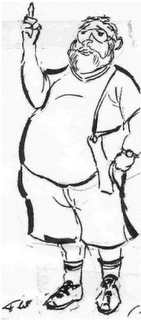 |
| author - a former chess champion of Brussels. |
The current rules of chess have been used since about 1580, starting in Italy. At the end of the 16th century and during the 17th century, the best players of the word were Spanish and Italian. In the 18th century, the supremacy went to France (Philidor and La Bourdonnais). In the 19th century, England became the most important country for chess. The London chess club was founded in 1807.
The title of Chess Champion of the World dates officially to 1886 (Steinitz), but even before that some players were known to be the best of their time. A dated list of the best players of the word is the following:
| Andre Philidor | (France) | 1747 – 1795 |
| Louis La Bourdonnais | (France) | 1821 – 1840 |
| Howard Staunton | (England) | 1843 – 1851 |
| Adolf Anderssen | (Germany) | 1851 – 1858 |
| Paul Morphy | (U.S.A.) | 1858 – 1859 |
| William Steinitz | (Austria) | 1866 – 1894 |
| Emanuel Lasker | (Germany) | 1894 – 1921 |
| Jose Raoul Capablanca | (Cuba) | 1921 – 1927 |
| Alexander Alekhine | (Russia/France) | 1927 – 1935 |
| Max Euwe | (Holland) | 1935 – 1937 |
| Alexander Alekhine | (Russia/France) | 1937 – 1946 |
| Mikhail Botvinnik | (U.S.S.R.) | 1948 – 1957 |
| Vassily Smislov | (U.S.S.R.) | 1957 - 1958 |
| Mikhail Botvinnik | (U.S.S.R.) | 1958 – 1960 |
| Mikkail Tal | (U.S.S.R.) | 1960 – 1961 |
| Mikhail Botvinnik | (U.S.S.R.) | 1961 – 1963 |
| Tigran Petrossian | (U.S.S.R.) | 1963 – 1969 |
| Boris Spassky | (U.S.S.R.) | 1969 – 1972 |
| Bobby Fischer | (U.S.A.) | 1972 – 1975 |
| Anatoly Karpov | (U.S.S.R.) | 1975 – 1985 |
| Garry Kasparov | (U.S.S.R.) | 1985 – ? |
We see a supremacy of the (ex) Soviet Union, starting in 1948. (Alekhine who became a French citizen and died in 1946.)
Two Americans have been World champion. Another American, Hans Berliner, was also world champion by correspondence in 1968. Dr. Berliner's work with computer chess at Carnegie University attracted world attention. His Hi-tech program was one of the first to defeat chess masters.
Most people consider Robert James (Bobby) Fischer to have been the best chess player of all time, but some consider Paul Morphy to have been as good as Fischer. Let's have a look at a game that Paul Morphy won in only seventeen moves against Adolf Anderssen who was the best in the world for the eight years before him. This game, played only a few days before Christmas, is a wonderful example of Morphy's skill in creating a situation where his tactical skills could wreak havoc and devastation.
Morphy – Anderssen, 1858

|
| diagram #1 |
1. e4 c5 2. Nf3 Nc6 3. d4 cxd4 4. Nxd4 e6 5. Nb5 (diagram #1)
Taimanov variation of the Sicilian. It's inter-esting to see such a modern opening being played well over a century ago.
5... d6 6. Bf4 e5 7. Be3 f5?
Anderssen seeks to open things up and give himself an opportunity to launch one of his dazzling attacks. This had always worked for him before, but it played into Morphy's hands. Modern opening theory considers this to be a weak move for Black. (More common now is 7... Nf6 8. Bg5 a6.)
8. N1c3!
Morphy continued his development in preparation for punishing Black's premature aggression.
8... f4 9.Nd5!
Better than anyone before him, Morphy understood the value of initiative and how it is often much more important than mere material.
9... fxe3
Anderssen was already in trouble, but this move would only add to it. Kf7 might have been wiser.
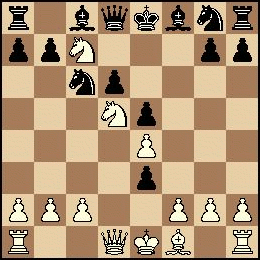
|
| diagram #2 |
10.Nbc7+ (diagram #2)
10... Kf7
[10...Kd7 11.Qg4#]
11. Qf3+?
Now that his target had been driven into the open, Morphy pursued relentlessly. In this case though, it was a mistake. Nxa8 would have been a much better move; Morphy's immediate pursuit of the black king would have given Anderssen a small chance to draw.
11... Nf6 12. Bc4 Nd4! 13. Nxf6+ d5!
It's unlikely that Anderssen has calculated all variations after Kg6, but his instincts told him it led to disaster. [13... Kg6 14. Qh5+ Kxf6 15. Ne8+ Qxe8 16. Qxe8 Nxc2+ (16... d5 17. 0–0–0 !) 17. Kf1 e2+ ! (17... Nxa1 18. g4 !) 18. Bxe2 Nxa1 19. g4 ! and despite a good material balance Black is defenseless against the new wave of attack. -- Kasparov]
14. Bxd5+ Kg6?
[14...Qxd5 was the safest option, although White has an advantage in the endgame: 15.Nfxd5+ Nxf3+ 16.gxf3 exf2+ 17.Kxf2; 14...Ke7 ! could have made Morphy regret his over-ambitious 11th move, e.g. 15.Qh5 gxf6 16.Qf7+ Kd6 17.Nxa8 -- Kasparov]

|
| digram #3 |
15. Qh5+ (diagram #3)
15... Kxf6 16.fxe3!
A classic Morphy move! The open f-file ends and with it any hope Black has had. His King is exposed and the White rook has an open file to join the attack. [The tempting 16. Ne8+ ? 16... Qxe8 17. Qxe8 Bb4+ would have been disastrous for White.]
16...Nxc2+

|
| Paul Morphy - 1859 |
Anderssen could have held out a little longer with Qxc7, but the end result would still have been the same. [16... Qxc7 17. Rf1+ Nf5 18. Rxf5+ ! 18... Bxf5 19. Qxf5+ Ke7 20. Qe6+ Kd8 21. 0–0–0 ! 21... Bd6 22. Bxb7 -- Kasparov]
17. Ke2
Black resigned. Anderssen realized that his exposed king with White's pieces all about, is doomed, especially with the open f-file. It was a very impressive demolition of the strongest European player of the time.

_html_m534e45df.gif)
+(Solution)_html_m245e84ea.png)










